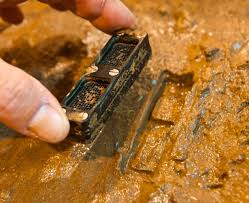
Teixobactin, is the first in a new class of antibiotics. The tendency of bacteria to become resistant to antibiotics by mutating threatens to significantly set back the practice of medicine. However, finally some enterprising researchers have started to think like a bacterium to come up with "new" ideas.
Did you ever ask yourself where antibiotics come from? There are millions of bacteria and fungi in every scoop of soil and they exist in thousands of different varieties. How do they survive? Like every other living creature, they battle one another to acquire nutrients available in their environment. In other words, by isolating the "antibiotics" that fungi and bacteria create to fight one another, we can develop and use those antibiotics to likewise battle bacteria and fungi that invest and sometimes kill us.
The genius of the researchers Kim Lewis, Slava Epstein, and team from Germany, England, and NovoBiotic Pharmaceuticals in Massachusetts, who have worked to develop teixobactin for over a decade, is the development of the ichip. A soil sample is diluted and poured onto the ichip in the hope of catching only one microbe in each of a series of holes that cover the ichip, which is then covered with special membranes with pores that allow the flow of nutrients to the bacterium or fungus but block the movement of fungi and bacteria. The ichips are then replaced in the soil where they thrive on nutrients they find there, but they are not contaminated or attacked by other bacteria or fungi because they are isolated and protected from them. About half the bacteria thus isolated have been grown in ichip cells and about three-quarters of the ichip bacteria can then be transferred to lab solutions where they continue to grow. To date the teixobactin antibiotic has saved the lives of many mice infected with virulent staph and other germs. Undoubtedly many more years of research and millions, probably billions of dollars will be spent before teixbactin and similar antibiotics are developed by using the ichip method to provide new and resistant-proof cures for the many bacterial and fungal diseases that plague mankind.Now what about viruses?
Did you ever ask yourself where antibiotics come from? There are millions of bacteria and fungi in every scoop of soil and they exist in thousands of different varieties. How do they survive? Like every other living creature, they battle one another to acquire nutrients available in their environment. In other words, by isolating the "antibiotics" that fungi and bacteria create to fight one another, we can develop and use those antibiotics to likewise battle bacteria and fungi that invest and sometimes kill us.
The genius of the researchers Kim Lewis, Slava Epstein, and team from Germany, England, and NovoBiotic Pharmaceuticals in Massachusetts, who have worked to develop teixobactin for over a decade, is the development of the ichip. A soil sample is diluted and poured onto the ichip in the hope of catching only one microbe in each of a series of holes that cover the ichip, which is then covered with special membranes with pores that allow the flow of nutrients to the bacterium or fungus but block the movement of fungi and bacteria. The ichips are then replaced in the soil where they thrive on nutrients they find there, but they are not contaminated or attacked by other bacteria or fungi because they are isolated and protected from them. About half the bacteria thus isolated have been grown in ichip cells and about three-quarters of the ichip bacteria can then be transferred to lab solutions where they continue to grow. To date the teixobactin antibiotic has saved the lives of many mice infected with virulent staph and other germs. Undoubtedly many more years of research and millions, probably billions of dollars will be spent before teixbactin and similar antibiotics are developed by using the ichip method to provide new and resistant-proof cures for the many bacterial and fungal diseases that plague mankind.Now what about viruses?
 RSS Feed
RSS Feed